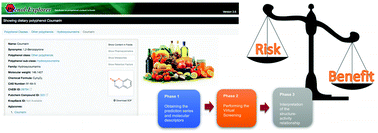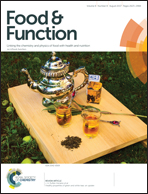In silico genotoxicity of coumarins: application of the Phenol-Explorer food database to functional food science
Abstract
Coumarins are a group of phytochemicals that may be beneficial or harmful to health depending on their type and dosage and the matrix that contains them. Some of these compounds have been proven to display pro-oxidant and clastogenic activities. Therefore, in the current work, we have studied the coumarins that are present in food sources extracted from the Phenol-Explorer database in order to predict their clastogenic activity and identify the structure–activity relationships and genotoxic structural alerts using alternative methods in the field of computational toxicology. It was necessary to compile information on the type and amount of coumarins in different food sources through the analysis of databases of food composition available online. A virtual screening using a clastogenic model and different software, such as MODESLAB, ChemDraw and STATISTIC, was performed. As a result, a table of food composition was prepared and qualitative information from this data was extracted. The virtual screening showed that the esterified substituents inactivate molecules, while the methoxyl and hydroxyl substituents contribute to their activity and constitute, together with the basic structures of the studied subclasses, clastogenic structural alerts. Chemical subclasses of simple coumarins and furocoumarins were classified as active (xanthotoxin, isopimpinellin, esculin, scopoletin, scopolin and bergapten). In silico genotoxicity was mainly predicted for coumarins found in beer, sherry, dried parsley, fresh parsley and raw celery stalks. The results obtained can be interesting for the future design of functional foods and dietary supplements. These studies constitute a reference for the genotoxic chemoinformatic analysis of bioactive compounds present in databases of food composition.



 Please wait while we load your content...
Please wait while we load your content...